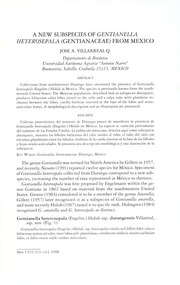
A NEW SUBSPECIES OF 'GENTIANELLA HETEROSEPALA' (GENTIANACEAE) FROM MEXICO PDF
Preview A NEW SUBSPECIES OF 'GENTIANELLA HETEROSEPALA' (GENTIANACEAE) FROM MEXICO
NEW A OF GENTIANELLA SUBSPECIES FROM MEXICO HETEROSEPALA (GENTIANACEAE) VILLARREAL JOSE A. Q. Botdmca Departamento de Umversidad Autonoma Agraru ABSTRACT Holub The (Engelm.) Mexico. species rosepala in i Duran nientes del noroesce de Holub Me: (Engelm.) en epa/a Estados Unidos. La poblacion s Key Words: Gencianaceae, Durango, Mexico. Gentianella, The genus Gentianella was revised for North America by Gilletc in 1957, and Nesom (1991) reported twelve species for Mexico. Specimens recently, new Durango from correspond sub- oi Gentianella heterosepala collected to a number Mexico increasing the of taxa represented in to thirteen. species, Engelmann was proposed by within the ge- Gentianella heterosepala first United nus Gentiana 1862 based on material from the southwestern in member Greene (1904) considered to be a of the genus Amarella; States. it recognized subspecies oi Gentianella amarella, Gillett (1957) later as a it Holmgren and more recently Holub (1967) raised to specific rank. (1984) it recognized G. amarella and G. heterosepala as distinct. Holub durangensis Gentianella heterosepala (Engelm.) Villarreal, ssp. nov. (Fig. ssp. 1) Gentianellaeheterosepalae{^ngeim) Holub. ssp. heterosepalae i\m\Y\s sed differt lobis calycis ViLLARREAL GentiancUa heterosepala 113 Q., cm Stems decumbent 30-60 Plants annual. erect to at the base, tall, 3- subclasping, not basally connate, spreading, 5 -nerved, glabrous, ovate, cm cm long, 2-2.5 wide proximally, base auriculate, apex acuminate, 5 margin minutely Flowers mostly 1-4 cymes, on narrowly denticulate. in cm 2—6 winged pedicels long, glabrous, terminal on the primary branches and axillary branches arising mostly on the upper 1/3 of the stem; calyx of five sepals, two of them foliaceous, opposite, covering the remaining calyx, mm mm 6-10 ovate, 10-15 long, wide, base cuneate, apex acuminate, trinervate, green, the middle portion joined to the tube, the tube cam- mm panulate, 3-5 long with glandular trichomes between the lobes, the mm mm three lobes lanceolate, 8-10 long, 1.5-2 wide, one of them 3-5 mm wide, acuminate, trinervate, green at the tips; corolla yellowish with mm some blue in the lobes, funnelform, the tube 10—12 long, with a ring mm mouth, 5-6 stamens of filaments the the lobes ovate, long; the at five, filaments flattened, adnate to the base of the corolla, the anthers dorsifixed, mm upper Ovary narrowly long, separated the portion. 1.5 at elliptic, 1 mm cm cm 5-6 long, stigmas fruit narrowly elliptic, 2-2.5 long, wide. 2; km MEXICO. Type.. Duranco: Mpio. Canelas, 2<S.5 al sueste de Canelas, por el camino a Durango, bosque de pino, 2650 m, 6 Oct 1985, Socorro Gonzalez 3446, y M. Gonzalez MEXU; ANSM, CIIDIR). (hcm.otyph: isotypes: km Durango: Additional specimens examined: Mpio. Canelas, 19 de Canelas, por el camino a Durango, bajio inundable en bosque de pino, 2560 m, 5 Oct 1985, Socorro Gonzalez 3391, M. Gonzalez Y. Herrera (ANSM, CIIDIR). Mpio. Canelas, predio particular y member Gentianella heterosepala a of the section Amarella (Gillett 1957) is and distinguished by a calyx with two bracteate foliaceous sepals that is The enclose the remaining calyx and portion of the corolla. inner calyx cm The 2-7.5 and lobes are usually of different length. pedicels are long, mm 15-20 Borner the corollas long. Gentianella amarella (L.) ssp. acuta (Michx.) Gillett which grows in the same area, has a calyx tube with lobes shown equal or unequal in width (but not foliaceous, as in Figure c-d), 1 shorther pedicels and smaller flowers. The hybridization between the two species not considered. Gentianella heterosepala occurrs primarily in the is New southwestern United (Utah, Colorado, Idaho, Arizona, and States Mexico), where grows meadows, streambanks and open aspen-pine in it m 2000-3400 (Holmgren forest at 1984). known Mexico from Gentianella heterosepala ssp. durangensis in the is m Madre municipio of Canelas the Sierra Occidental of northwest of m 2600-2700 Durango, where woodlands pine localized in at altitude it is and disjunct from the southernmost population in the United States by about 600 kilometers. Plants of the Mexican populations are chanicterizeel mm by a calyx tube 3-5 long with three lanceolate lobes, and two foHa- ceous lobes joined on the outside, glandular trichomes on the tube between and the calyx lobes, corolla fimbriae inserted at the base of the lobes, ovate- The United auriculate leaves (Fig. States populations {G.h. ssp. I). mm heterosepala) have a short calyx tube (1-2 long) with the foliaceous when sepals free to the base, and present, a rim of glandular tichomes at the middle The of the calyx tube. corolla fimbriae are united in a scale at the base of each lobe, the leaves are usually elliptic-oblong, narrow at the base, and occasionally ovate. TEX and .tion, i HoLUB, Neue namen 1967. innerhalb dcr gactun^^cn Gentuuid J. Ma Lind Comastomata (Wettst.) Tokokunki. Folia Gcobot. Phytt Nesom, Taxonomy Mi G.L. 1991. oi Gmttanella (Gentianaceae) in
